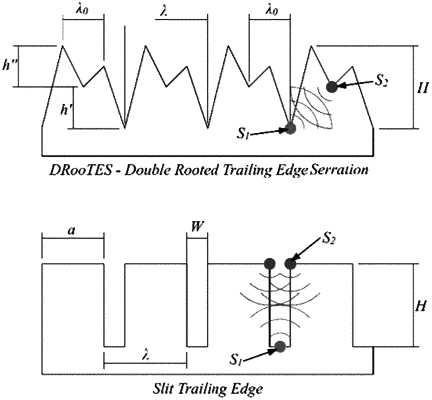| CPC F03D 1/0675 (2013.01) [F05B 2240/3042 (2020.08); F05B 2250/182 (2013.01); F05B 2250/183 (2013.01); F05B 2260/96 (2013.01)] | 20 Claims |

|
1. A method for forming an add-on component for an aerofoil having a leading edge and a trailing edge, said component being formed in order to reduce the amplitude of sound produced at frequency fpeak when air flows in a flow direction from the leading edge of the aerofoil over the trailing edge of the component at a freestream velocity U∞, the method including the steps of:
(a) selecting a frequency fpeak of sound that is to be reduced;
(b) selecting a freestream velocity U∞ of air;
(c) providing a component having a joining edge for joining to a trailing edge of an aerofoil and a trailing edge opposite said joining edge;
(d) forming the trailing edge of the component into a plurality of pairs of peaks, each of said pairs having a first trough, a first peak, a second trough, a second peak, which is a greater distance from the joining edge than the first peak, and a third trough, wherein the first trough is on one side of the first peak, the second trough is between the first and second peak, and the third trough is on the other side of the second peak to the second trough;
(e) wherein the first and third troughs of each pair of peaks lie substantially on a first axis, the second troughs of each pair of peaks lie substantially on a second axis, and the second peaks of each pair of peaks lie on a third axis;
(f) and wherein the component is formed according to the formula:
 where d′ is from 0.4 to 0.8 and
 where h′ is the shortest distance between the first axis and the second axis, h″ is the shortest distance between the 2nd and 3rd axis, fpeak is the frequency of sound to be reduced and U∞ is the freestream velocity in the flow direction of air flowing over the trailing edge of the component.
|